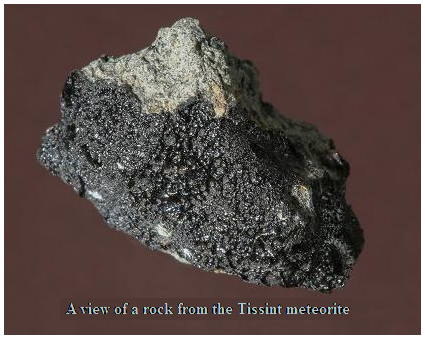More evidence has come to light that life on earth may have origins in Mars, says S.Ananthanarayanan.
The earth is the only planet that we know of that has the conditions to support life. But the mechanism by which the first living organisms came to be on the earth is still in conjecture. One serious possibility is that life originated elsewhere, but came to the earth, perhaps on a meteorite. And the planet Mars, which is similar to the Earth in many ways, has been imaginatively, and is now, more scientifically, considered a place where life may have originated.
In July, 2011, a large meteorite, which arose after being ejected from the planet Mars after an asteroid strike, crashed near the town of Tissint, in the Moroccan desert. Analyses of fragments of the meteorite showed traces of carbon and clear evidence of the presence of water on Mars, sometime in the past, which reignited the theory of life having arisen on Mars. Lin Yangtin and others, at Ecole Polytechnique, Lausanne, Switzerland, report in the journal, Meteoritics and Planetary Sciences, that further analyses of a fragment of the meteorite argue strongly for the source of carbon being biological.

Origin of life
That the building blocks of life, in the form of amino acid molecules, of which proteins are composed, could self-assemble from the raw material was demonstrated by the celebrated Miller-Urey experiment of 1952. Water vapour, methane, ammonia and hydrogen gases, which may represent the ancient atmosphere of the earth, were subjected to repeated electric sparks, to simulate stormy conditions that may have prevailed at that time. After a week of such stimulation, it was found that a number of amino acids had been formed. Similar trials by other experimenters, with a few more components added, have generated many more organic molecules associated with life, including all the 20 amino acids found in nature, and the then some more.
The Miller-Urey experiment is the basis for aboigenesis, the widely held view that life may have originated in the early earth, when essential raw materials and the conditions for generation of many organic substances were present, at various stages of the earth’s history. But a paper by Prof Stephen Benner, of the Westheimer Institute for Science and Technology, Tampa Bay, USA, in Aug 2013 said that even the correct raw materials for life would not stick together to form RNA and DNA, but would just turn to something like tar, when exposed to energy, in the form of heat and light.
Prof Benner said that there was need for some specific elements, which could enable the building block of life to get their act together, and two of these were the elements, molybdenum and boron. While the presence of minerals that contain both these elements seem to be vital for life to get started, the form of molybdenum that is required is a highly oxidized form. Prof Benner notes that the early earth, of three billion years ago, was oxygen deficient and the molybdenum that was present would not have formed oxides. And then, the early earth was covered with water, which rules out the presence of boron, which is found only in the driest of places. Water is also corrosive to RNA, considered the first genetic molecule to have appeared, and this is another reason to consider that life could not have originated on the early earth.
Prof Benner noted that analysis of the Tissint meteorite, as the piece of Mars that had come down in 2011 near the town of Tissint, had come to be called, showed that there was boron on Mars. Mars, unlike the early earth, also had oxygen, and that there was now evidence that there was the oxidized form of molybdenum too. And although there is evidence of past liquid water on Mars, it covered only parts of the planet, unlike on the early earth. According to Prof Benner the origin of life was, in fact, impossible on the earth, and the evidence pointed in the direction of Mars. But a paper by Andrew Steele and others of the Carnegie Institute, in 2012, had suggested that the traces of carbon found in the Tissint meteorite, which suggest organic matter, were associated with rocks that arose in molten magma and were not likely to have come from biological sources. The question of whether life originated on Mars was hence still open.
Lausanne report
The current report, from the group in Lausanne, appears to swing the evidence back to the side of the carbon in the Mars rocks having been of biological origin. The chemical, microscopic and other analyses of the carbon in the rocks clearly show that the carbon content did not arise from the earth and had been deposited in the Tissint meteorite even while it was a rock formation in Mars. And as for the question of how the carbon came into the rocks, this is again indicated by the ratio of C-12 and C-13, the two forms, called isotopes, of the carbon atom, in the carbon found in the Tissint.
The isotopes of atoms are forms that differ only in the number of neutral particles in the nucleus, which means the atoms have the same chemical properties, but a small different in mass. While there is a constant ratio of the two forms in the atmosphere, in living things, there is a preference for one of the forms over the other, and the ratio is a little different. The ratio of the two isotopes in the Tissint rock was compared with the ratio in the atmosphere of Mars, which is now known thanks to the work of the Phoenix and Curiosity lander probes, and it was found that the ratio was different. This then does not agree with the case that the carbon in the rock came from the atmosphere. But another remarkable observation is that the difference between the two ratios is the same as that between the ratio in a piece of coal, which is of biological origin, and the that of the earth’s atmosphere! This strongly suggests that the carbon content in the Tissint rock came from biological matter that seeped into fissures in the rock, in at least partly liquid conditions.
“Insisting on certainty is unwise, particularly on such a sensitive topic……… but the grounds to hold that there has been biological activity on Mars is compelling,” says Philippe Gillet, Director of the laboratory at Lausanne. “The evidence seems to be building that we are actually all Martians, that life started on Mars and came to Earth on a rock,” Professor Benner had said in 2013. “It’s lucky that we ended up here nevertheless, as certainly Earth has been the better of the two planets for sustaining life. If our hypothetical Martian ancestors had remained on Mars, there might not have been a story to tell,” Prof Benner said.

Do respond to : response@simplescience.in
------------------------------------------------------------------------------------------